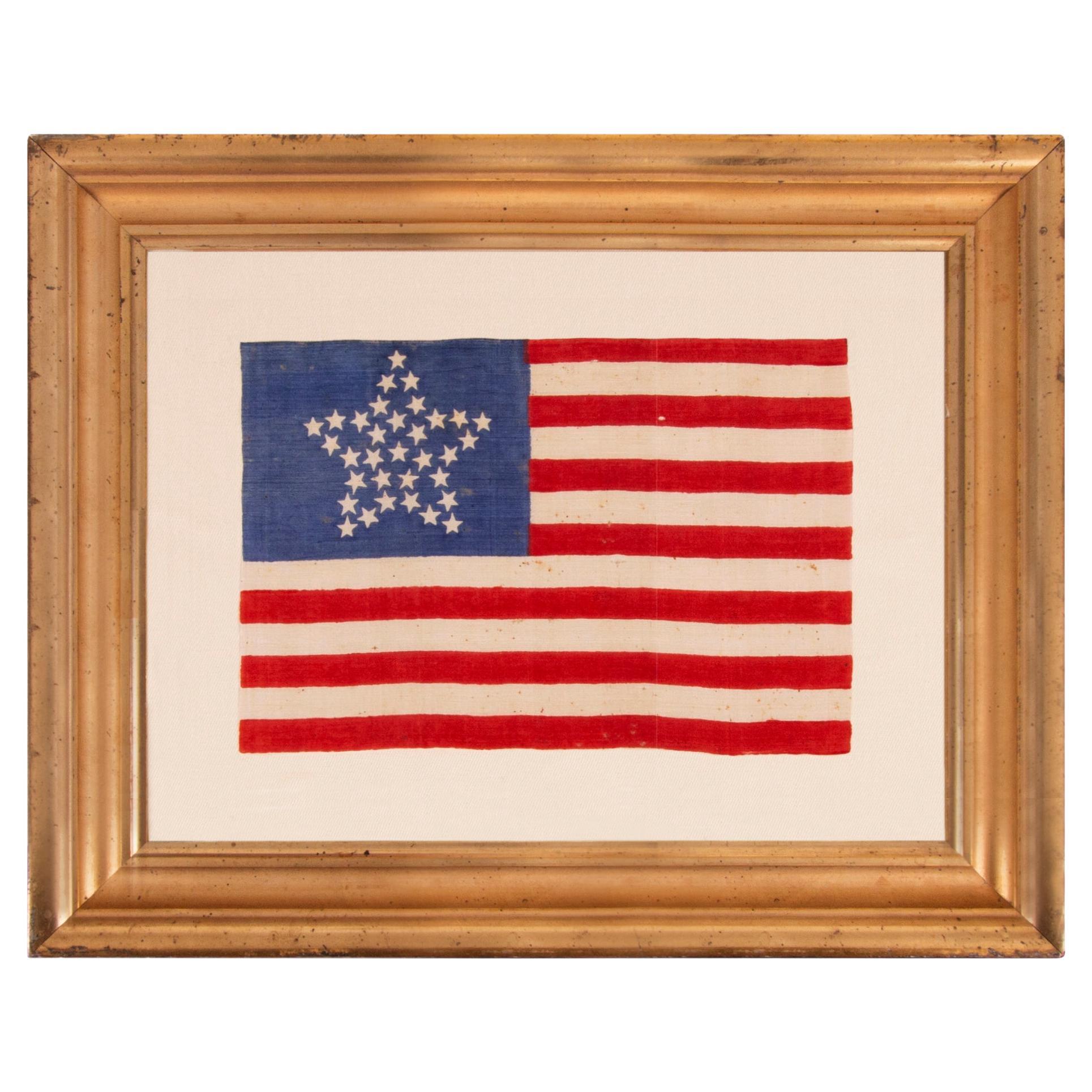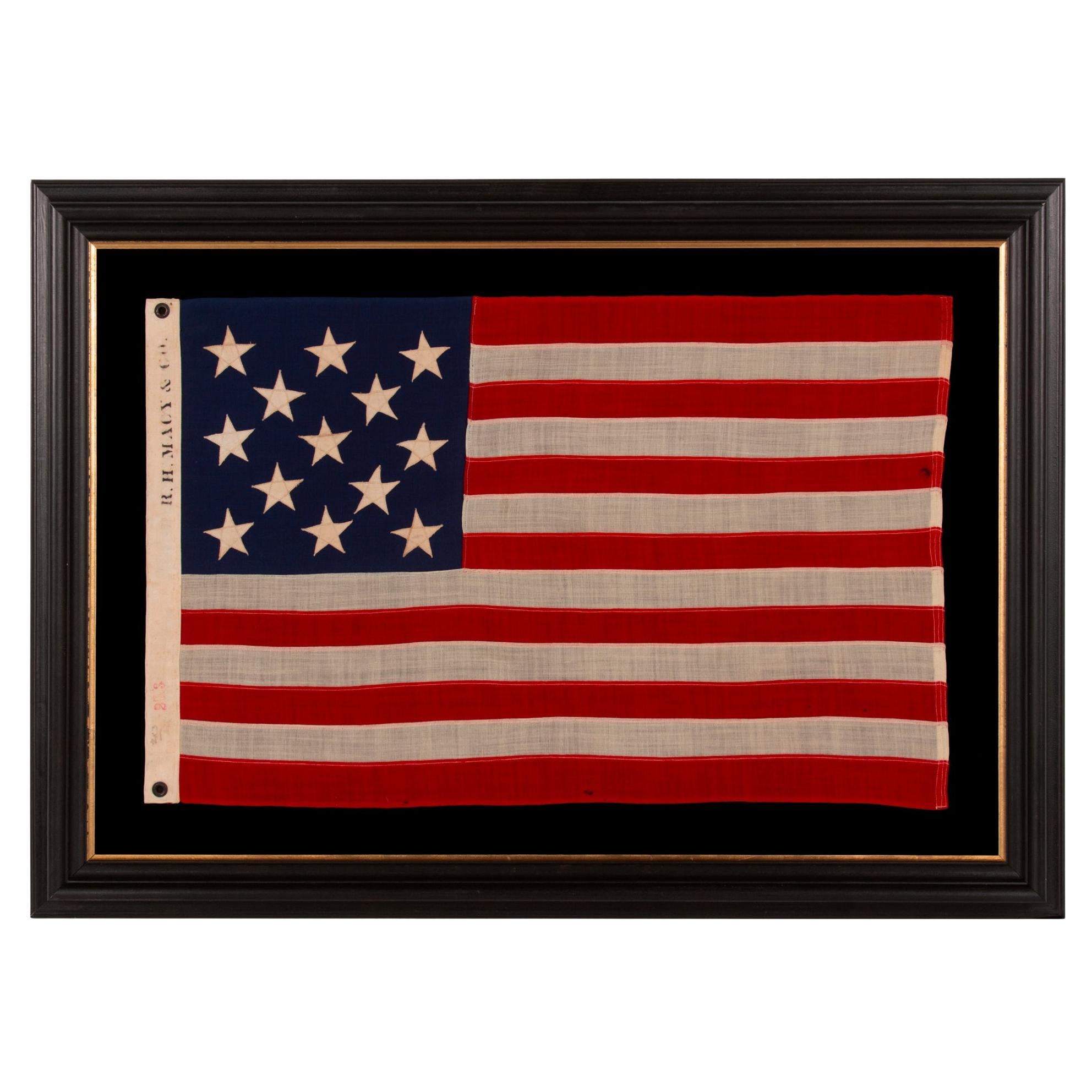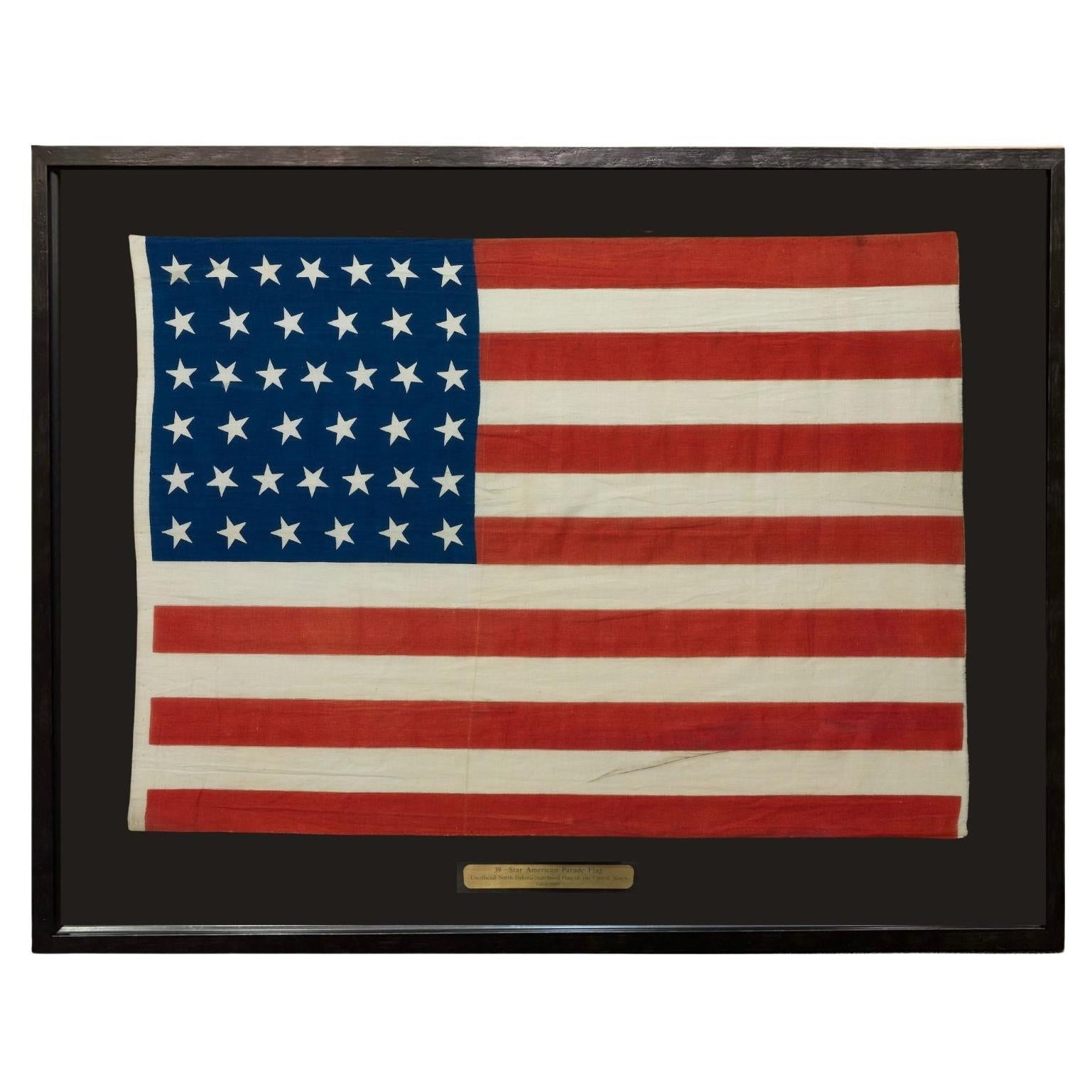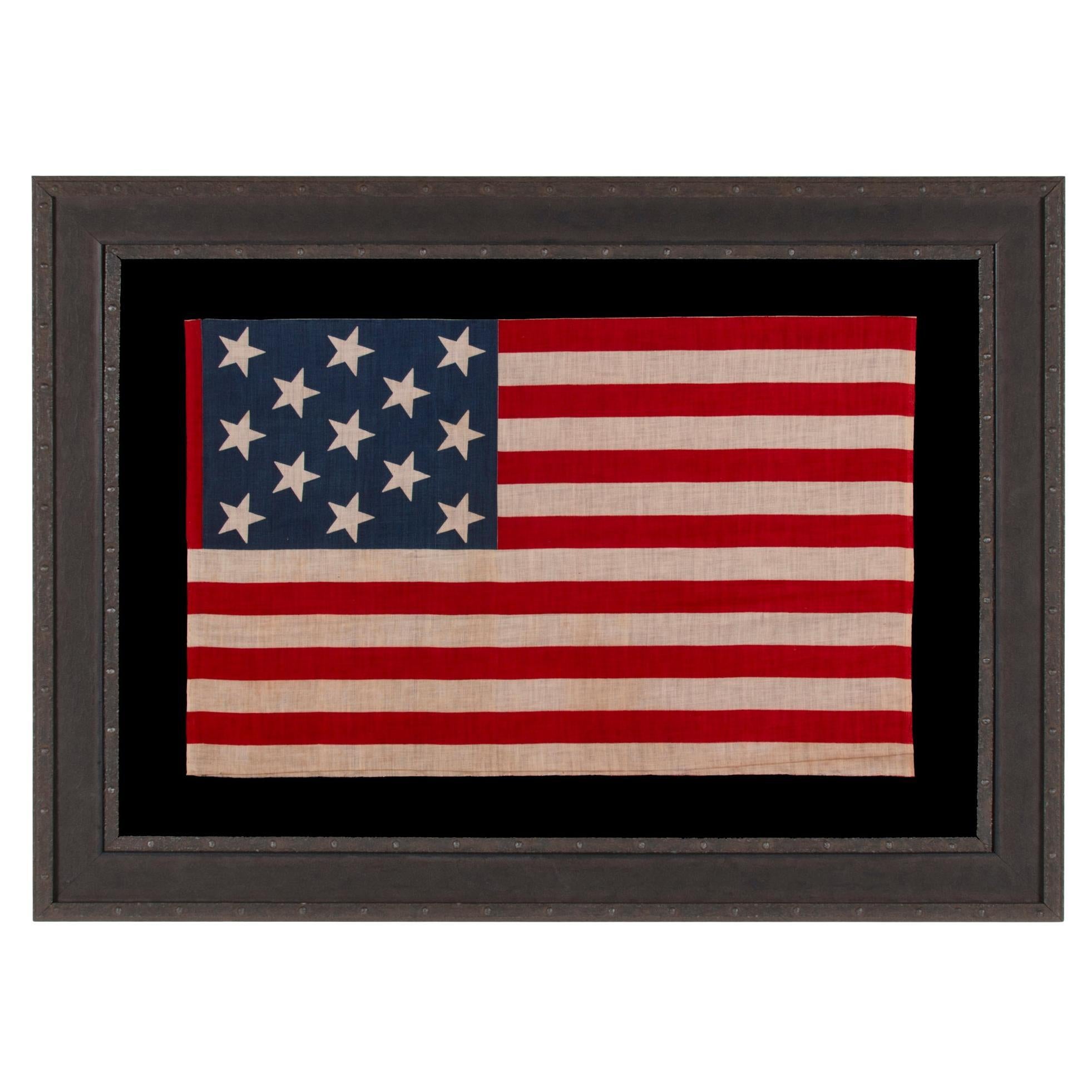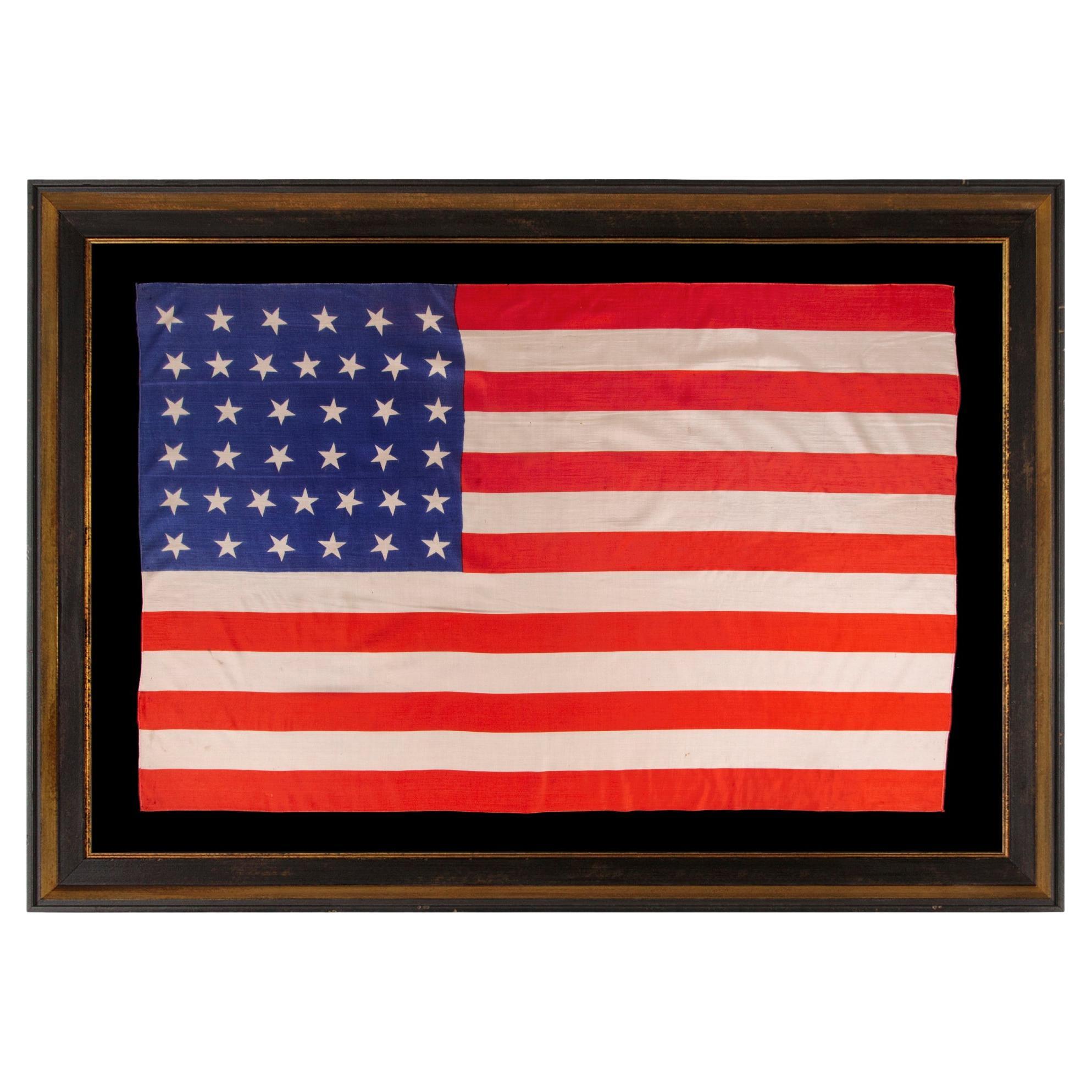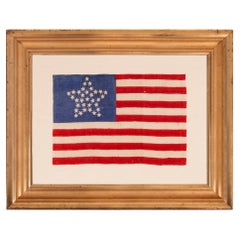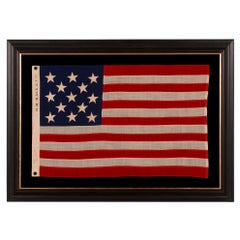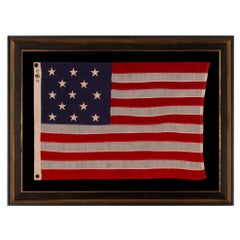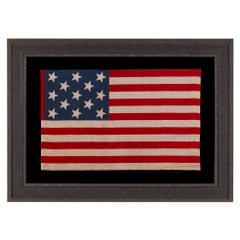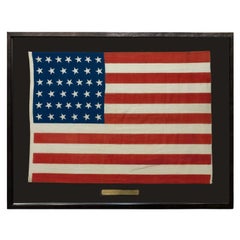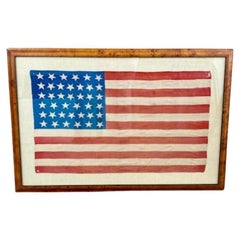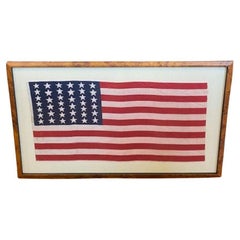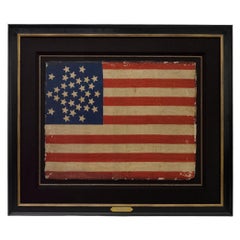Items Similar to 13 Star Antique American Flag with a Narrow Star Presentation, ca 1876
Want more images or videos?
Request additional images or videos from the seller
1 of 6
13 Star Antique American Flag with a Narrow Star Presentation, ca 1876
Price Upon Request
Price Upon Request
Price Upon Request
Price Upon Request
Price Upon Request
Price Upon Request
Price Upon Request
Price Upon Request
Price Upon Request
Price Upon Request
Shipping
Retrieving quote...The 1stDibs Promise:
Authenticity Guarantee,
Money-Back Guarantee,
24-Hour Cancellation
About the Item
13 STAR ANTIQUE AMERICAN FLAG WITH HAND-SEWN STARS IN AN EXTREMELY NARROW PRESENTATION OF A 3-2-3-2-3 ARRANGEMENT ON A CANTON THAT DOESN’T FOLLOW SUIT, LEAVING WIDE EXPANSES OF BLUE WOOL BUNTING ABOVE AND BELOW; MADE IN THE ERA OF THE 1876 CENTENNIAL OF AMERICAN INDEPENDENCE, POSSIBLY AS A U.S. NAVY SMALL BOAT ENSIGN
13 star American national flag, made in the era of the 1876 centennial of American independence. The stars are hand-sewn, made of cotton, and double-appliquéd (applied to both sides). The canton and stripes are made of wool bunting that has been pieced and hemmed with treadle stitching. Both the fly and hoist ends have been hemmed in the same manner, with the latter folded over onto itself, in such a way that the latter is exposed on the obverse of the flag, on the interior edge of the sailcloth canvas binding that was applied and bound with treadle stitching.
The stars are arranged in lineal rows of 3-2-3-2-3, but in a very peculiar and graphically intriguing manner. Note how these were pressed into a surprisingly narrow, horizontally aligned regimen, in such a way that a wide expanse of blue was left both above and below within a traditionally-shaped, navy blue canton that doesn’t conform to what’s inside.
In most cases the 3-2-3-2-3 design can also be viewed as a diamond of stars, with a star in each corner and a star in the very center, or as a combination of the crosses of St. Andrew and St. George, which some feel could have been the design of the very first American flag and may identify a link between this star configuration and the British Union Jack. Here, with the configuration so compressed, these two secondary patterns can still be seen, but are a bit harder to visualize. The 3-2-3-2-3 pattern is often attributed--erroneously in my opinion--to New Jersey Senator Francis Hopkinson, a member of the Second Continental Congress and signer of the Declaration of Independence, who is credited with having played the most significant role in the original design of the American national flag. Hopkinson's original drawings for the design of the flag have not survived and his other depictions of 13 star arrangements for other devices are inconsistent.
A secondary design that does curiously appear more clearly on this particular flag, than it does in most 3-2-3-2-3 formations, is a circle of 6 stars with a single, center star, flanked to each side by columns of 3 stars.
13 star flags have been flown throughout our nation’s history for a variety of purposes, both practical and utilitarian. The U.S. Navy flew 13 star flags not only in the Revolutionary and early Federal periods, following the First Flag Act of June 14th, 1777, but throughout much or all of the 19th century, particularly the second half. As the total number of states increased, and subsequently the number of stars on our nation’s flag, the Navy often maintained various counts, lower than the actual, especially on smaller flags, to ensure that the stars themselves would be easier to discern at a distance. Primarily these “small boat ensigns,” as they are called, displayed 13 stars to reflect the original 13 colonies. Flag experts disagree about precisely when the Navy began to employ this practice. Some feel that the use of 13 star flags never stopped, which seems to be supported by depictions of ships in period artwork. Less consistent prior to the Civil War, but more-so afterwards, the tradition continued until 1916, when President Woodrow Wilson wrote an Executive Order that ended the Navy’s use of 13 star flags in favor of small flags in the full star count.
The 3-2-3-2-3 pattern began to appear on U.S. Navy small boat flags in the closing years of the Civil War, in or around 1864. U.S. Navy regulations of 1870, effective until updated in 1882, specified small boat ensigns in 5 different sizes, one of which was 3.7 feet on the hoist by 7 on the fly, designated as a “No. 12.” At approx. 3.79 feet on the hoist, this particular flag was likely produced for that function. The Navy made its own flags, sometimes in house, but often subcontracted to wives, sisters, and mothers of seamen, which lent to some irregularity. This would explain the oddly narrow arrangement of the otherwise expected star design. The folding of the wool bunting with an exposed edge, along the fly, is indicative of Navy construction. The size of the stars and the fact that they point in varied directions are precisely what I would expect in this period. At 5.8 feet on the fly, I strongly suggest that it was originally longer, then properly turned back and re-bound during its original course of use. Beyond the factors just described, this supposition is further supported by the piecing of the 7th stripe, comprised of one long segment, plus an extremely small one at the fly. Although U.S. Navy flags often display stripes constructed from multiple segments of fabric, it's unusual to see such a tiny fragment at the end of a center stripe especially.
Navy flags of this scale, in this particular time frame, generally employed a single brass grommet at the top and bottom of the hoist. Evidence that this flag once had them is present around the edges of small holes, in the expected locations, through which small lengths of hemp rope were at some point added.
More Information on 13 Star Flags in Early America
In addition to their use on U.S. Navy ships, some private ships flew 13 star examples throughout the 19th century. 13 star flags were hoisted at all manner of patriotic events, including Lafayette’s return visit and tour of America in 1824-25, the 1876 centennial of American independence, and celebrations of Independence Day. They were displayed during the Civil War, to reference past struggles for American liberty, and were used by 19th century politicians in political campaigning for the same reason. The use of yachting ensigns with a wreath of 13 stars, surrounding a fouled anchor, which allowed pleasure boats to bypass customs between 1848 and 1980, persists today without an official purpose. Because any American flag that has previously been official remains so according to the flag acts, it remains perfectly acceptable to fly 13 star flags today by way of congressional law. Throughout history, and even today, they are boldly displayed at every presidential inauguration.
Mounting: For 25 years we have maintained a specialized department for this purpose. Our lead conservator holds a master's degree in textile conservation from one of the nation’s top university programs. We take great care in the mounting and preservation of flags and related textiles and have preserved thousands of examples.
The flag has been hand-stitched throughout to a supportive fabric (flat-lined). It was then hand-stitched to a background of 100% cotton, black in color, that was washed and treated for colorfastness. The mount was then placed in a black-painted, hand-gilded and distressed Italian molding. The glazing is U.V. protective acrylic (Plexiglas).
Condition: The flag was obviously flown for an extended period and displays wear in accordance with this fact. There are modest to moderate losses along the fly end, particularly most notable the most notable of which occur at the end of the third 5th, 7th, 8th, 10th, and 13th stripes There are moderate to significant darning repairs in several locations within the canton, accompanied by minor to moderate instances of the same in the 4th – 6th white stripes. Fabric of similar coloration was placed behind the flag throughout, for masking purposes. Brass grommets would have at one time been present at the top and bottom of the binding, later removed (undoubtedly by someone who did not understand early flags, under the false supposition that it would not have originally had them—a common occurrence). Many of my clients prefer early flags to show their age and history of use.
Frame Size (H x L): 57.25" x 82.5"
Flag Size (H x L): 45.5" x 70"
- Dimensions:Height: 57.25 in (145.42 cm)Width: 82.5 in (209.55 cm)Depth: 2.5 in (6.35 cm)
- Materials and Techniques:
- Place of Origin:
- Period:
- Date of Manufacture:1876
- Condition:See Item Description.
- Seller Location:York County, PA
- Reference Number:Seller: 13j-17051stDibs: LU849744143092
About the Seller
5.0
Recognized Seller
These prestigious sellers are industry leaders and represent the highest echelon for item quality and design.
Established in 1991
1stDibs seller since 2008
70 sales on 1stDibs
Typical response time: 1 to 2 days
- ShippingRetrieving quote...Shipping from: York County, PA
- Return Policy
Authenticity Guarantee
In the unlikely event there’s an issue with an item’s authenticity, contact us within 1 year for a full refund. DetailsMoney-Back Guarantee
If your item is not as described, is damaged in transit, or does not arrive, contact us within 7 days for a full refund. Details24-Hour Cancellation
You have a 24-hour grace period in which to reconsider your purchase, with no questions asked.Vetted Professional Sellers
Our world-class sellers must adhere to strict standards for service and quality, maintaining the integrity of our listings.Price-Match Guarantee
If you find that a seller listed the same item for a lower price elsewhere, we’ll match it.Trusted Global Delivery
Our best-in-class carrier network provides specialized shipping options worldwide, including custom delivery.More From This Seller
View All33 Star Antique American Flag with a Great Star Configuration, ca 1859-1861
Located in York County, PA
33 STARS ANTIQUE AMERICAN FLAG WITH A "GREAT STAR" CONFIGURATION ON A BRILLIANT, INDIGO BLUE CANTON, A RARE AND EXTRAORDINARY EXAMPLE, PRE-CIVIL WAR THROUGH THE WAR'S OPENING YEAR, 1...
Category
Antique Late 19th Century American Political and Patriotic Memorabilia
Materials
Silk
13 Star Antique American Flag, Marked "R.H Macy & Co", circa 1895-1926
Located in York County, PA
13 STAR ANTIQUE AMERICAN FLAG WITH A 3-2-3-2-3 CONFIGURATION OF STARS; A SMALL-SCALE EXAMPLE, MADE IN THE 1895-1926 ERA, MARKED “R.H. MACY & CO.”
13 star antique American flag of th...
Category
Antique Late 19th Century American Political and Patriotic Memorabilia
Materials
Wool
Price Upon Request
13 Star Antique American Flag, Inscribed "Spenge" ca 1895-1926
Located in York County, PA
13 STAR ANTIQUE AMERICAN FLAG WITH A 3-2-3-2-3 CONFIGURATION OF STARS ON AN ATTRACTIVE, INDIGO BLUE CANTON; A SMALL-SCALE EXAMPLE OF THE 1895-1926 ERA, INSCRIBED WITH THE SURNAME “SP...
Category
Antique Late 19th Century American Political and Patriotic Memorabilia
Materials
Wool
13 Star Antique American Parade Flag, ca 1876-1899
Located in York County, PA
13 STAR ANTIQUE AMERICAN PARADE FLAG, WITH A 3-2-3-2-3 CONFIGURATION OF STARS, AN EXTREMELY SCARCE AND UNUSUALLY LARGE VARIETY, MADE circa 1876-1899
13 star American national parade...
Category
Antique Late 19th Century Canadian Political and Patriotic Memorabilia
Materials
Cotton
Price Upon Request
38 Star Antique American Flag, Colorado Statehood, circa 1876-1889
Located in York County, PA
38 star antique American parade flag with scattered star orientation, made of silk, with generous scale and vivid colors, Colorado Statehood, 1876-1889
38 star American national p...
Category
Antique Late 19th Century American Political and Patriotic Memorabilia
Materials
Silk
Price Upon Request
34 Star Antique American Flag with Hourglass Medallion Stars, ca 1861-1863
Located in York County, PA
EXTRAORDINARY 34 STAR ANTIQUE AMERICAN FLAG WITH AN ACCORDION OR HOURGLASS MEDALLION CONFIGURATION THAT SURROUNDS A PENTAGON OF STARS IN THE CENTER; MADE OF FINE SILK AND ENTIRELY HAND-SEWN; MADE DURING THE OPENING YEARS OF THE CIVIL WAR (1861-63), IN A TINY SIZE AMONG ITS COUNTERPARTS OF THE PERIOD; REFLECTS THE ADDITION OF KANSAS AS THE 34TH STATE
34 star flag of the Civil War period with an array of rare, beautiful, and otherwise desirable features. Extremely small among flags of this period with pieced and sewn construction, the flag displays a star pattern that is not only highly unusual, but unique to this particular example. This consists of a single star in the very center, surrounded by a pentagon of stars, flanked by angular bracket of three stars to either side. Above and below are rows of 5 stars, followed by rows of 6 that line the top and bottom of the canton. The resulting configuration is what I have termed an “accordion medallion,” though “hourglass medallion” or “standing bow tie” would be perfectly acceptable.
When rotated 90 degrees, to view the harder-to-identify, bow tie formation, students of early star patterns may note the visual similarity between this and what I call “Starburst” or “Crosshatch” medallions. The pattern, however, conspicuously lacks the crosses of St. Andrew (a saltire) and St. George (roman cross), that would allow it to be more accurately categorized as such.
Entirely hand-sewn, the canton and stripes of the flag are made of fine silk. The hemming of this was accomplished with great skill. The top and bottom edges are selvedge. These are so similar in nature as to have come from the same maker. There is a white, silk binding along the hoist, in the form of an open sleeve, through which a length of braided hemp rope was passed, expertly looped and re-braided into itself at the top and bottom for strength.
The stars are made of white, polished cotton. These were stitched to both sides (double-appliqued). Note how the edges of the fabric were not turned under, providing evidence of the fact that the maker was not especially skilled in appliqueing. This was common, as applique work was far more difficult than producing French seams.
In the 19th century, most flags with pieced and sewn construction were 8 feet long and larger. A six-footer was considered small. Even military battle flags, carried on foot, measured 6’ x 6.5’, which translates into approximately 7’ x 7.5’ after framing, about the size of an average quilt and larger than can comfortably fit on a wall in a house with 8-foot ceilings and average width baseboard. Flags smaller than this were produced both commercially and at home, but the smaller they are, the more unusual they are. At just 26.5 x 46.5 inches, this flag is extremely small for a Civil war period flag with sewn construction.
Silk was both beautiful and lightweight, which made it elegant for military unit colors and preferable for flags meant to be carried on foot. Most outdoor use flags...
Category
Antique 1860s American Political and Patriotic Memorabilia
Materials
Silk
You May Also Like
39-Star Antique American Flag with 'Whimsical' Star Pattern, 1889
Located in Colorado Springs, CO
This is a 39-star unofficial American flag, handmade and printed on cotton. The flag dates to 1889 and has a unique history, thanks to its rare star-count.
The flag’s canton is prin...
Category
Antique 1880s American Political and Patriotic Memorabilia
Materials
Cotton
19th Century American 39 Star Flag, circa 1889
Located in Nantucket, MA
19th Century American 39 Star Flag, circa 1889, a period printed silk parade flag with a wavy pattern of dancing stars. This was never an official flag of the United States but was m...
Category
Antique 1880s American Federal Political and Patriotic Memorabilia
Materials
Silk
19th Century 39 Star American Flag, circa 1889
Located in Nantucket, MA
19th Century 39 Star American Flag, circa 1889, a printed linen ensign with 39 stars arranged in a wavy star pattern, with stripes in a very unus...
Category
Antique 1880s American Federal Political and Patriotic Memorabilia
Materials
Linen
31-Star Printed American Flag, Celebrating California Statehood, Circa 1850
Located in Colorado Springs, CO
This is a rare 31-star medallion printed American flag, celebrating the addition of California to the Union. The flag is printed on silk and has a spectacular “Great Star” canton pat...
Category
Antique 1850s American Political and Patriotic Memorabilia
Materials
Silk
38-Star Antique American Flag with Unique Canton, circa 1876-1890
Located in Colorado Springs, CO
This is a striking 38-star American flag. The flag dates to 1876-1890, when Colorado (represented by the large star in the center of the flag’s canton) joined the Union as the 38th s...
Category
Antique Late 19th Century American Political and Patriotic Memorabilia
Materials
Muslin
38-Star American Parade Flag, Flown at a Reception for President Grant, 1880
Located in Colorado Springs, CO
This is a beautifully colored 38-star American parade flag, flown at a public reception for Ulysses S. Grant in October of 1880. This printed flag features a rare, triple medallion s...
Category
Antique 1880s American Political and Patriotic Memorabilia
Materials
Cotton
More Ways To Browse
Civil War Antiques
Framed American Flags
Antique Brass Star
19th Century American Flag
Revolutionary War Antique
Antique Stripe Fabric
Centennial 1876
Flag Diamond
American Flag Cotton
Small American Flag
Antique American Flag Framed
Navy Flags
United Wilson
Pink 70s Furniture
Brass Jacks
Gilded Age Antiques
Narrow Display Case
Antique Hemp
